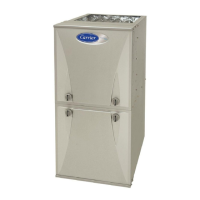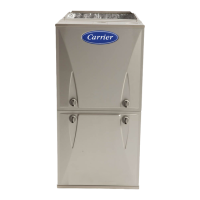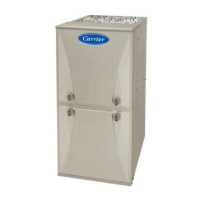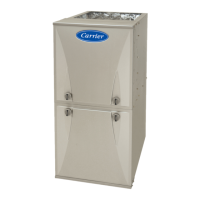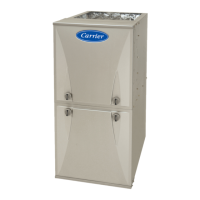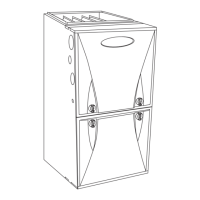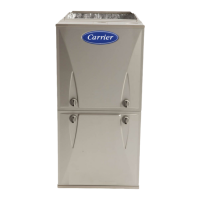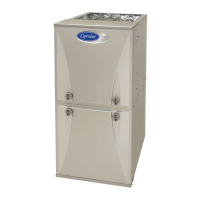58
Table 16 – Blower Speed Taps
COLOR SPEED
FACTORY ATTACHED
TO:
Gray 5 Cool
Yellow 4 Spare
Blue 3 Heat
Orange 2 Spare
Red 1 LO HT/Cont. Fan
(Read following caution before changing taps).
UNIT DAMAGE HAZARD
To avoid operating outside the rise range and avoid
component damage:
1. NEVER connect Speed Tap 1 (Red) wire to “HEAT.”
2. NEVER connect Speed Tap 2 (Orange) wire to “HEAT”
on all models.
CAUTION
!
To change blower motor speed selections for heating mode,
remove blower motor lead from control HEAT terminal. (See Fig.
35) Select desired blower motor speed lead from one of the other
motor leads and relocate it to HEAT terminal. (See Table 16 for
lead color identification.) Reconnect original lead on SPARE
terminal.
Adjust Blower Off Delay (Heat Mode)
The blower off delay has four adjustable settings from 90 sec to
180 sec. (See Table 17.) The blower off delay jumpers are located
on the furnace control (See Fig. 35 and Fig. 63.) To change the
blower off delay setting, move the jumper from one set of pins on
the control to the pins used for the desired blower off delay.
Factory blower off delay setting is 120 sec.
Table 17 – Blower Off Delay Jumper Positions
PINS 1AND2 2AND3 3AND4 4AND5
Time (in sec.) 90 120 150 180
Adjust Cooling Airflow
The cooling airflow can be set from the remaining blower speed
taps. Refer to the Air Delivery Tables in these instructions.
Adjust Continuous Fan Airflow
The Continuous Fan airflow can be set from the remaining blower
speed taps. Refer to the Air Delivery Tables in these instructions.
The Continuous Fan speed can be changed to any other speed tap
by toggling the Fan switch at the thermostat. See the Sequence of
Operation for details.
FIRE HAZARD
Failure to follow this warning could result in personal
injury, death, and/or property damage.
Reinstall manifold pressure tap plug in gas valve to prevent
gas leak.
!
WARNING
FURNACE OVERHEATING HAZARD
Failure to follow this caution may result in reduced furnace
life.
Recheck temperature rise. It must be within limits specified
on the rating plate. Recommended operation is at the
mid--point of rise range or slightly above.
CAUTION
!
Adjust Thermostat Heat Anticipator
When using a non--electronic thermostat, the thermostat heat
anticipator must be set to match the amp draw of the electrical
components in R--W circuit. Accurate amp draw readings can be
obtained at the thermostat subbase terminals R and W. Fig. 53
illustrates the easy method of obtaining actual amp draw. The amp
reading should be taken after blower motor has started and furnace
is heating. Connect ammeter wires as shown in Fig. 53. The
thermostat anticipator should not be in the circuit while measuring
current. If thermostat has no subbase, the thermostat must be
disconnected from R and W wires during current measurement.
See thermostat manufacturer’s instructions for adjusting heat
anticipator and for varying heating cycle length. For an electronic
thermostat, set cycle rate for 3 cycles per hr.
Check Safety Controls
The flame sensor, gas valve, and pressure switch were all checked
in the Start--up procedure section as part of normal operation.
1. Check Main Limit Switch
This control shuts off combustion system and energizes air--
circulating blower motor, if furnace overheats. By using this
method to check limit control, it can be established that lim-
it is functioning properly and will operate if there is a re-
stricted return--air supply or motor failure. If limit control
does not function during this test, cause must be determined
and corrected.
a. Run furnace for at least 5 minutes.
b. Gradually block off return air with a piece of cardboard or
sheet metal until the limit trips.
c. Unblock return air to permit normal circulation.
d. Burners will re--light when furnace cools down.
2. Check Pressure Switch(es)
This control proves operation of the draft inducer blower.
a. Turn off 115--v power to furnace.
b. Disconnect inducer motor lead wires from wire harness.
c. Turn on 115--v power to furnace.
d. Set thermostat to “call for heat” and wait 1 minute. When
low pressure switch is functioning properly, hot surface
igniter should NOT glow and control diagnostic light
flashes a status code 31. If hot surface igniter glows when
inducermotorisdisconnected,shutdown furnaceimmedi-
ately.
e. Determine reason low pressure switch did not function
properly and correct condition.
f. Turn off 115--v power to furnace.
g. Reconnect inducer motor wires, replace door, and turn on
115--v power.
h. Blower will run for 90 sec before beginning the call for
heat again.
i. Furnace should ignite normally.
59SP5A

